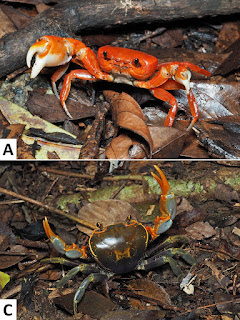 |
| Nanhaipotamon incendium & N. aureomarginatum Huang, Ying & Shih, 2021 |
Abstract
Two morphologically distinct new species of Nanhaipotamon Bott, 1968, are described from Huizhou, Guangdong Province, southern China. The smooth carapace and lack of flagellum on the third maxilliped exopod immediately separate N. incendium n. sp. from all other known Nanhaipotamon. It is also the first species of this genus to be recorded from a relatively high altitude of 700 m a.s.l. Nanhaipotamon aureomarginatum n. sp. is externally much more typical of species of its genus but can be distinguished from congeners by its unique male first gonopod. The two new species are more or less sympatric with a morphological disparate congener, which we tentatively assign as N. aff. aculatum Dai, 1997 and N. aff. hongkongense (Shen, 1940), respectively, but with different habitats. A genetic analysis using the mitochondrial cytochrome oxidase subunit I shows that while the two new species are sufficiently distinct from other known species of Nanhaipotamon, they have extraordinarily close relationships with their respective sympatric congeners, which calls for further investigation. The ecology of these two new species are also noted.
Key words: cytochrome oxidase subunit I (COI), hillstream, new species, sympatric, systematics
 |
| Nanhaipotamon incendium n. sp., male, from type locality, specimen not collected. |
Family Potamidae Ortmann, 1896
Subfamily Potamiscinae Bott, 1970
Genus Nanhaipotamon Bott, 1968
Type species. Potamon (Potamon) formosanum Parisi, 1916,
by original designation; gender neuter.
Nanhaipotamon incendium n. sp.
Diagnosis. Carapace broader than long, regions indistinct (Fig. 1). Dorsal surface smooth, finely pitted, convex (Fig. 1). Anterolateral margins smooth, lined with numerous indistinct granules (Fig. 1). Posterolateral surfaces smooth (Fig. 1). Sub-orbital, sub-hepatic and pterygostomial regions clearly divided by sutures, with smooth and pitted surface (Fig. 2A). Maxilliped III exopod reaching to proximal one-fifth of merus, flagellum absent (Fig. 3A). G1 slender, reaching beyond pleonal locking tubercle almost up to suture between sternites IV/V in situ (Fig. 2D). G1 subterminal segment 2.6–2.7 × as long as terminal segment, tapering distally. G1 terminal segment relatively small, inverted foot-shaped; inner proximal margin strongly concave; inner distal margin almost straight to gently convex; apex acute, directed outward, orientation oblique to longitudinal axis of G1 (Figs. 3C–E, 7I, J). G2 subterminal segment 2.0–2.1 × as long as flagellum-like terminal segment (n = 3) (Fig. 3B).
Etymology. The specific name “incendium” means fire in Latin, which describes the live colouration of the species. The name thus is to be conceived as a noun in the nominative singular standing in apposition to the generic name.
 |
| Nanhaipotamon aureomarginatum n. sp., male holotype (37.7 × 30.7 mm), SYSBM 001807, from type locality. |
Nanhaipotamon aureomarginatum n. sp.
Diagnosis. Carapace broader than long, regions indistinct (Fig. 4). Dorsal surface generally smooth, pitted, convex, slightly rugose on anterolateral regions in smaller specimens (Fig. 4). Anterolateral margins cristate with fused granules, bent inward posteriorly (Fig. 4). Posterolateral surfaces with low, oblique striae converging posteriorly; granules scattered among striae, some merged together (Fig. 4). Sub-orbital, pterygostomial regions covered with large round granules; sub-hepatic region with lines of fused smaller granules (Fig. 5A). Maxilliped III exopod reaching to proximal one-third of merus, with flagellum (Fig. 6A). G1 slender, reaching beyond suture between sternites IV/V in situ (Fig. 5D). G1 subterminal segment 2.1–2.2 × as long as terminal segment. G1 terminal segment large, duck head-shaped; mesial margin strongly convex; outer margin strongly concave; anterior margin almost straight, oblique to longitudinal axis of G1; apex pointing outwards (Figs. 6C–E, 7K, L). G2 subterminal segment 1.7–1.8 × as long as flagellum-like terminal segment (Fig. 6B).
Etymology. The specific name “aureomarginatum” alludes to the new species’ golden-coloured anterolateral margins of the carapace. The name thus is to be conceived as an adjective in the nominative singular.
Chao Huang, Si Ying and Hsi-Te Shih. 2021. Two New Freshwater Crab Species of the Genus Nanhaipotamon Bott, 1968 (Crustacea, Decapoda, Potamidae) from Huizhou, Guangdong Province, southern China. Zootaxa. 5026(2); 221-238. DOI: 10.11646/zootaxa.5026.2.4



